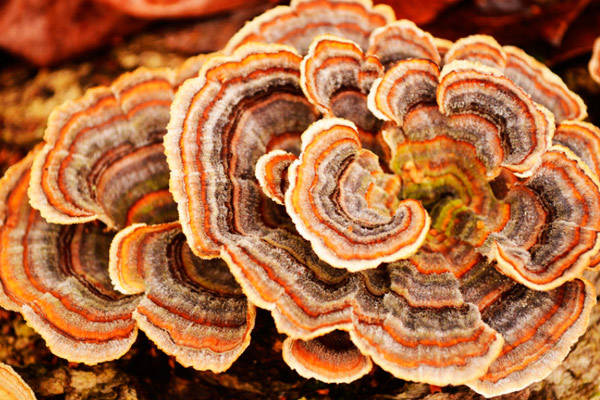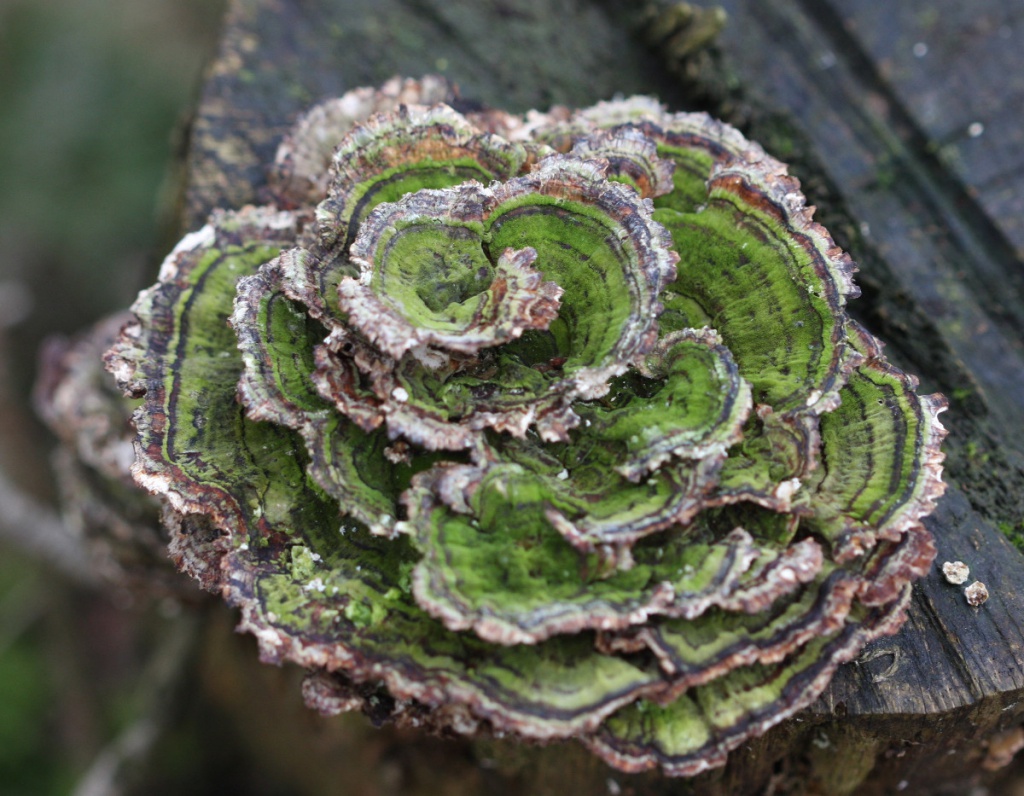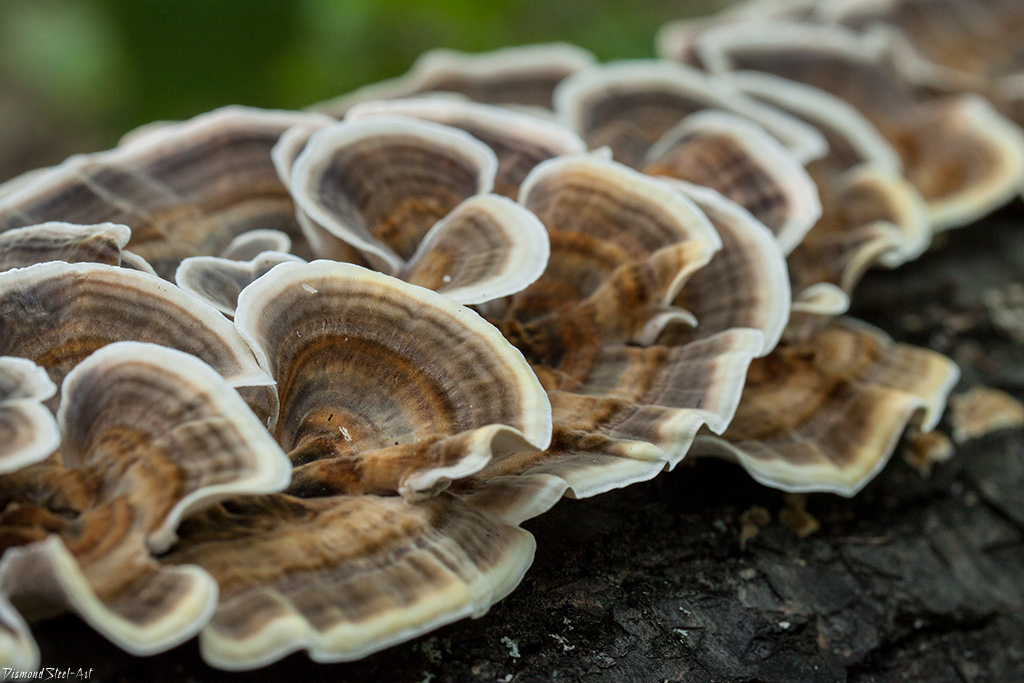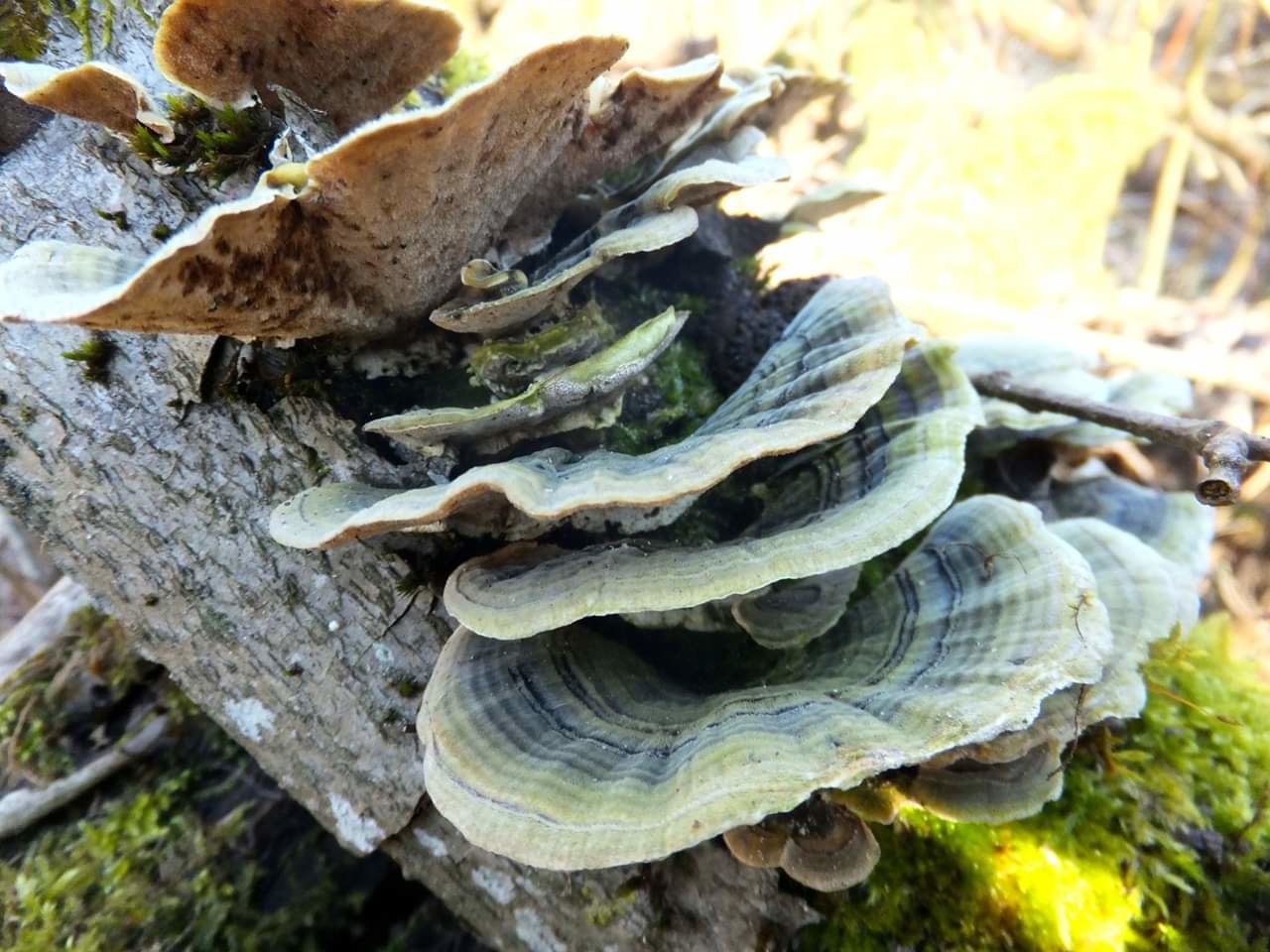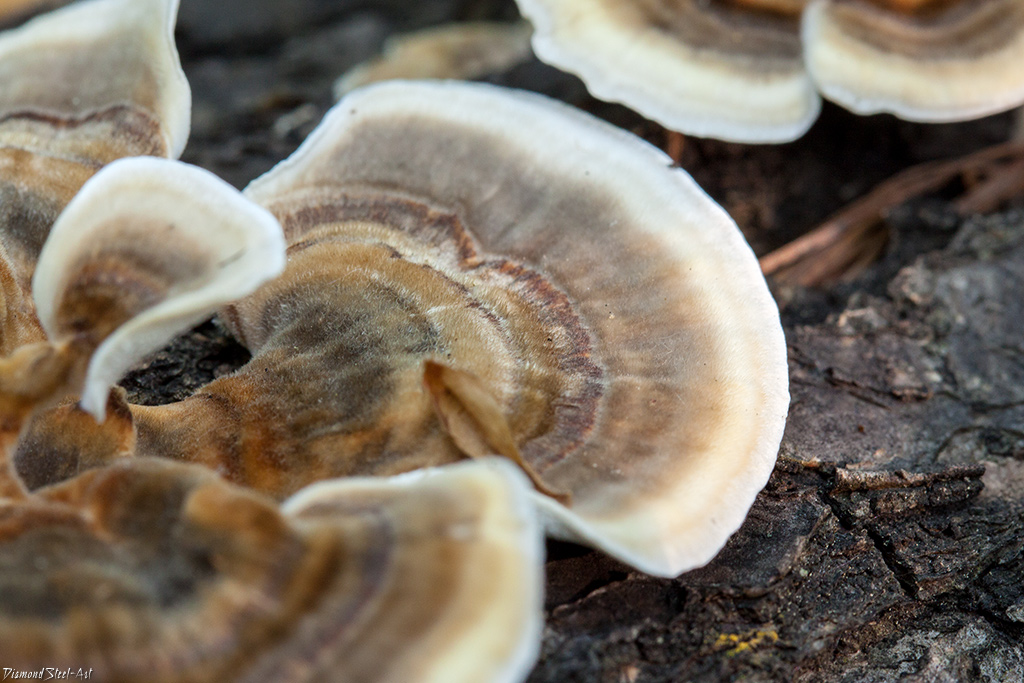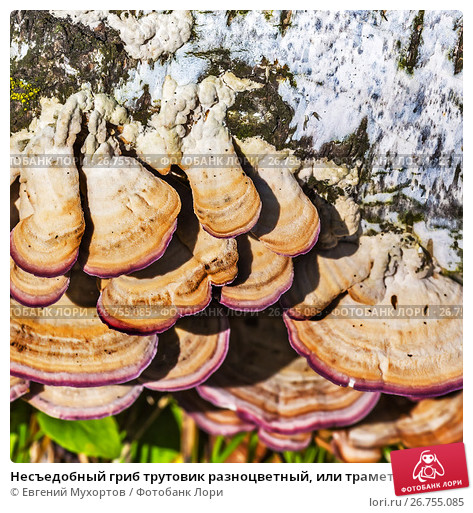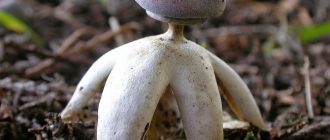Application of multicolored tramestones
Recently, researchers have begun to isolate and identify substances present in this medicinal mushroom that can act like pharmaceuticals. Two of these substances are the polysaccharide peptide (PSP) and the polysaccharide krestin (PSK). Scientists believe these chemicals can fight cancer and boost the immune system.
Trametes multicolored, PSP and PSK are used to treat:
- herpes
- chronic fatigue syndrome
- hepatitis A
- pulmonary diseases
- ringworm and a skin condition called impetigo
- upper respiratory tract infections
- urinary tract infections (UTIs)
- digestive tract infections
- liver diseases, including hepatitis
Tinder fungus is also used for:
- stimulating the immune system
- reducing the amount of phlegm
- improve bodybuilding results
- increasing energy levels
- reducing toxic effects and pain from chemotherapy and radiation therapy
- increase the effectiveness of chemotherapy
- increasing life expectancy and improving the quality of life of cancer patients
- improve appetite
Trametes multicolored contains polysaccharide peptide (PSP) and polysaccharide-K (PSK, krestin), which are able to fight tumor growth and strengthen the immune system.
Trametes multicolored - description, where it grows, the poisonousness of the mushroom
Trametes multicolored is a tinder fungus, which has a peculiar structure of the fruiting body (resembles a strongly unfolded fan). Grows in fairly large groups. Instances in groups are arranged as sockets. These representatives of the tinder family, belonging to inedible species, have a solid set of useful properties: antibacterial, antiviral.
Description of the species
Multicolored trametez is a perennial mushroom, the maximum size is up to 90 mm in width and 50 mm in length. The shape of representatives of this species can be completely different, most often it is rounded. In fact, it is a parasite fungus that grows to the trunk of trees.
The surface of the fruit body of the trametess is rather delicate, characterized by many convolutions with different color shades - from yellowish to dirty brown. As a rule, the edges are slightly lighter than the central part of the cap. The color of the base of the fruit body is dark olive, the pulp has a pleasant aroma.
Procurement of raw materials
Trametes belongs to inedible types of mushrooms, most often it is collected for subsequent harvesting for medicinal purposes. The peak of fruiting and harvesting is from August to September inclusive.
Harvesting tramesto involves cutting off young specimens and then cleaning them. After that, a special heat treatment is performed - the mushrooms are dried, while the temperature in the oven should be no more and no less than the specified values (range from 50 to 60 degrees). Thoroughly dried raw materials, as a rule, are crushed to obtain a powdery mass, which is poured into an airtight container (container or package) and sterilized.
Trametes in traditional medicine
This type of mushroom is widely known in Asian countries and has long been used as a remedy in Chinese traditional medicine. This is due to the content of many useful components in the mushroom pulp: bioactive polysaccharides, peptides, glycoproteins, triterpenes, saturated fatty acids, amino acids, vitamins and trace elements.
Basically, raw materials obtained from this mushroom are used for the treatment of oncological diseases (malignant neoplasms). A decoction from ready-made raw materials is prepared directly for treatment.
Also, often in Asian countries, trametes is used to treat a fairly large number of infectious diseases and ailments of internal organs. For these purposes, special mushroom infusions are prepared.
In Japan, trametes is used to treat diabetes mellitus, hypertension, rheumatism and thrombosis. As a rule, a medicinal ointment is prepared from the mushroom.
Application in traditional medicine
In Japan and China, raw materials from this type of mushroom are used as one of the components of the complex treatment of oncological diseases. This is because the use of trametess as a medicine helps make atypical cells more sensitive to the effects of chemotherapy and radiation therapy. Also, drugs based on this type of mushroom help in suppressing the inflammatory processes that accompany some ailments.
Contraindications and what to consider
However, you should not use raw materials obtained from the fruit bodies of trameta for the treatment of children, as well as women during the period of childbearing and lactation.
Any use of this remedy must always be agreed with the attending physician. Do not forget that any medicine can bring both benefits and harm to the body.
Interesting fact
- Trametes is also known under such names as Mist Mushroom, Wungji, Kawaratake.
- In Asian countries, to this day, trametes is used to treat inflammatory processes of the respiratory system.
- The most valuable mushroom is considered in Japan, the profit from the sale of finished raw materials reaches several million dollars annually.
External description of a multicolored trametess.
Its fruit body is perennial. Its shape is semicircular or fan-shaped, but in rare cases it is rosette-shaped. Its length is 5-8 centimeters, and its width reaches 5 centimeters. It is a sessile mushroom that grows sideways to the surface of the tree. Often several fruiting bodies grow together at the base.
The surface of the mushroom is completely covered with twisting thin areas of various shades, with alternating bare and fleecy areas. The edges of the cap of the multicolored trametess are lighter than the middle.
A characteristic feature of this type of mushroom is the multi-colored caps. On the top there may be areas of blue, white, silver, black, ocher yellow, brown, brown. The surface of the mushroom is shiny, silky to the touch. The base is most often narrowed, velvety, silky to the touch. The base shade is usually greenish.
The hymenophore of the multicolored trameta is represented by a tubular type, with small pores of irregular size and shape. The tubes have narrow edges. The color of the tubules is slightly yellowish, and in adulthood it becomes brownish, in rare cases a red tint can be observed.
The pulp is thin, leathery, light. Its color is white or brown, and when it fades, it becomes whitish, with almost no tint. The smell of the pulp of the multicolored trametess is pleasant.
Places of growth of multicolored tramestones.
Fruiting in these polypores occurs from mid-June to late October. They prefer to settle on old trees, logs, stumps, mainly on birches and oaks. In rare cases, multicolored trametess settle on conifers.
Variegated tinder fungi are often found, but they grow mainly in small groups, but they never occur singly. They are common in many forests on the planet. But on the territory of Russia, this species of tinder fungus is practically unknown. These fungi multiply rapidly and often cause heart rot on trees.
Efficiency of tramets from iherb, based on real reviews
In order not to get confused by the variety of products presented on the site, read the reviews of people who took this supplement.
Perfecti Mushrooms, Host Defense, Turkish Tail, 120 Vegetarian Capsules
The brand offers a 100% natural product. The product is produced in capsule form.It is recommended to take 2 capsules once a day with meals.
According to customer reviews, the product is highly effective:
“I have been taking trameta ever since I started chemotherapy, as recommended by my doctor. The drug helped me to undergo treatment with the most minimal side effects. For 6 months already I felt healthy, experienced a surge of energy. In the beginning, of course, the effect seemed insignificant, but after a few weeks I began to notice amazing results: the skin looked better, the balance and general condition improved. Of course it's expensive, but it's worth it. "
“I recommend to everyone who has this terrible disease - cancer. Great product that saves lives. "
"Taking the remedy, I was able to get rid of the initial stage of breast cancer."
Edibility, medicinal properties, benefits and contraindications
The mushroom is inedible, it is most often used in folk medicine and herbal medicine as an effective medicine.
Due to the content of nutrients and elements that make up this mushroom, it has the following medicinal properties:
- stimulates the immune system;
- increases the overall energy level in the body;
- side effects from chemotherapy and radiation therapy are reduced, their effectiveness is significantly increased;
- reduces the amount of phlegm in the respiratory tract;
- allows you to increase the overall life expectancy, especially in people suffering from cancer;
- normalizes appetite, stabilizes weight.
Polysaccharide-K (Kresin, PSK, PSP) is a cancer drug derived from this fungus. Its benefits are priceless. It is used side-by-side with chemotherapy in the treatment of cancer patients, and its other role is to play down the negative effects of drugs used in chemotherapy. The Japanese Ministry of Health and Welfare approved the remedy in the 1980s. The main cancers that the drug has helped solve are stomach and colorectal cancers.
Other diseases that this tinder fungus can fight against is malaria, a fever common in the tropics.
The usefulness of this mushroom is amazing. It is effective in maintaining blood sugar levels in diabetes mellitus, and is used in rheumatism and hypertension. It is able to reduce blood cholesterol levels, temperature and pain syndrome. Possesses antiviral and antibacterial properties. Strengthens the immune system.
It has no contraindications as such, but before using funds based on it, you should still consult a doctor, especially pregnant and lactating women.
The use of tramesto for medicinal purposes
The use of the Turkish tail is possible both for therapeutic and prophylactic purposes. Observe safety precautions when using the product!
Preparations based on tinder fungus
A drug based on this type of tinder fungus is prescribed for the prevention or in the complex therapy of diseases that are oncological in nature or predispose to cancer. Localization of pathological processes in which trametes is prescribed:
- Gastrointestinal tract;
- broncho-pulmonary system;
- genitourinary tract;
- mammary gland.
The drug shows good performance in the fight against:
- prostatitis;
- adenoma of the prostate gland;
- myoma of the uterus and other organs;
- fibroadenomatosis;
- diffuse fibrous mastopathy, etc.
The drug is available in capsule form. The starting dosage is 2 capsules per day (200 mg). But if necessary, the dosage regimen can be changed by increasing the concentration of trametess extract to 600 mg / day (6 capsules).
Important! Before starting treatment, be sure to consult your doctor!
Use in traditional medicine
On the basis of a multi-colored tinder fungus, several medicinal compositions are prepared:
- Tincture. You can buy it at a pharmacy or prepare it yourself by pouring 1 part of mushroom powder with 10 parts of vodka or alcohol. After 14 days, the product is ready for use.It should be taken in 15-40 drops, diluted or washed down with a sufficient amount of water. The product should be consumed three times a day, half an hour before or one hour after meals.
- Broth. 2 tbsp. l. Pour 1 liter of water into the chopped mushroom pulp and simmer under a lid over low heat for an hour. Thoroughly filter the finished medicine, squeeze out the cake. Drink the broth chilled 1 glass 2 times a day 30 minutes before meals.
Treatment with such folk remedies based on a multi-colored tinder fungus should be continued until the symptoms of the disease disappear. The duration of the 1st course is 2-3 weeks. After that, you need to take a break and, if necessary, repeat the therapy.
Be careful! Do not give such medicines to children under 14 years of age! They are also prohibited during pregnancy and lactation. Observe all safety measures, and in case of adverse reactions, consult a doctor immediately.
Side effects and safety
Trametess multicolored is arguably safe for most people when taken orally appropriately. So far, no side effects have been reported from taking this mushroom. However, people who received chemotherapy and took a chemical called PSK (extracted from the tinder fungus) experienced nausea, low white blood cell counts, and liver problems. It is unclear if these side effects are related to chemotherapy or PSK.
Special precautions and warnings
Pregnancy and breastfeeding: There is not enough reliable information on the safety of taking Tramerized Herb while pregnant or breastfeeding. To avoid side effects and possible harm to you and your baby, refrain from taking this remedy.
Interaction with various drugs
We currently do not have any information regarding drug interactions with other pharmaceuticals.
Is multicolored trameteou safe?
Trametez multicolored is considered safe, with few side effects reported in studies.
Some people may experience gastrointestinal symptoms such as gas, bloating, and dark stools while taking this mushroom.
When used as a cancer medicine along with chemotherapy, side effects have been reported including nausea, vomiting, and loss of appetite (,).
However, it is unclear if these side effects were related to Trametus or traditional cancer therapy ().
Darkening of fingernails () is another potential side effect.
Although it has a good safety profile, it is recommended that you talk to your doctor before starting to take a multicolored turkey supplement.
Trametes trogii what it looks like, where and how it grows, edible or not
Trametes Trog: photo and description
Trametes Trogii is a parasitic spongy fungus. Belongs to the Polyporov family and to the great family of Trametes. Its other names:
- Cerrena Trog;
- Coriolopsis Trog;
- Trametella Trog.
How does Trog's trametez look like?
The annual bodies of the trametes of Trog have the appearance of a regular or undulating rather fleshy semicircle, which is seriously adhered to the substrate by a flat lateral part. In the mushrooms that have just appeared, the edge of the cap is clearly rounded, after which it becomes thinner, becoming sharp. The length can be different - from 1.5 to 8-16 cm.The width from the trunk to the edge of the cap is 0.8-10 cm, and the thickness varies from 0.7 to 3.7 cm.
The surface is dry, covered with thick, long cilia-bristles of gold color. The edge of young specimens is velvety, with a pile, while overgrown specimens are smooth and hard. Implicit concentric stripes, slightly embossed, diverge from the place of growth. The color is grayish-white, yellowish-olive and brown, brown-golden and slightly orange or rusty red. With age, the cap darkens, becoming a honey-tea color.
The surface is tubular inside, with distinct large pores from 0.3 to 1 mm in diameter, complex shape. First of all, they are rounded, after which they become angularly serrated. The surface is uneven, rough. Color from bright white to cream and gray-yellowish. As it grows, it darkens, becoming a coffee color or a faded lilac hue. The thickness of the spongy layer is from 0.2 to 1.2 cm. White spore powder.
The flesh is whitish, changing its own color as it matures to a creamy gray and pale reddish olive. Rigid, fibrous cork. The dried mushroom becomes woody. The aroma is sour or pronounced mushroom, the taste is neutral-sweet.
Trametes Trog can be evenly spread with folded edges or an inverted spore-bearing sponge outward.
Where and how it grows
Trametes Troga prefers to settle on deciduous species - both soft and hard: birch, ash, mulberry, willow, poplar, walnut, beech, aspen. Not often you can see it on the pines. The mycelium in this species is long-term, fruiting bodies appear in the same places every year.
The mycelium begins to actively bear fruit from mid-late summer to stable snow. They grow singly and in large colonies, located in the form of tiles and side by side, very often you can meet ribbons grown together with the sidewalls of these fruit chalk.
Prefers sunny, dry, wind-protected places. It is distributed everywhere in the northern and temperate latitudes - in deciduous forests and taiga zones of Russia, in Canada and the United States. Sometimes it can be found in European countries, as well as in Africa and South America.
This species spoils the host trees, causing rapidly spreading white rot.
Eat a mushroom or not
Trametes Trog is an inedible species. No poisonous and toxic substances were found in its composition. The tough woody pulp makes this fruiting body unattractive to mushroom pickers. Its nutritional value is very low.
Doubles and their differences
Trametes Trog is similar to fruit bodies of its own kind and other tinder fungi.
Trametes is harsh-haired. Inedible, non-toxic. Can be recognized by very small pores (0.3x0.4 mm).
Long bristly villi are white or creamy
Fragrant trametes. Inedible, not poisonous. It is distinguished by the absence of pubescence on the cap, light, gray-white or silver color and a strong smell of anise.
Prefers loose poplar, willow or aspen
Gallic Coriolopsis. Inedible mushroom. The cap is pubescent, the spongy surface is dark-colored inside, the flesh is brown or brown.
It is easy to distinguish from Trog's trametess due to its darker color.
Antrodia. Inedible look. Their main difference is large-celled pores, sparse setae, white flesh.
This large genus includes varieties recognized as medicinal in the alternative medicine of the East.
Conclusion
Trametes Trog grows on old stumps, large deadwoods, besides damaged living trunks of deciduous trees. The fruiting body develops during the fall season and is able to survive the winter. It lives in one place for several years - until the complete destruction of the carrier tree. Can be found in the Northern and Southern Hemispheres. Widely popular in our country. In European countries, it is included in the lists of rare and endangered species. The mushroom is inedible because of the tough, unattractive pulp. No poisonous species were found among the twins.
Rich in antioxidants
Antioxidants are compounds that help inhibit or reduce damage caused by oxidative stress.
Oxidative stress occurs due to an imbalance between antioxidants and unstable molecules known as free radicals. This can lead to cell damage and chronic inflammation ().
This imbalance has also been associated with an increased risk of certain cancers and cardiovascular diseases (,).
Fortunately, eating foods rich in antioxidants or taking these powerful compounds in supplement form can reduce oxidative stress and inflammation.
Tumbleweed has an impressive amount of antioxidants, including phenols and flavonoids ().
In fact, one study identified more than 35 different phenolic compounds in a sample of Trametus extract, as well as the flavonoid antioxidants quercetin and baicalein ().
Phenol and flavonoid antioxidants support the health of the immune system by reducing inflammation and stimulating the release of protective compounds ().
For example, quercetin has been shown to promote the release of immunoprotective proteins such as interferon-y while inhibiting the release of the pro-inflammatory enzymes cyclooxygenase (COX) and lipoxygenase (LOX) ().
Contains immunostimulating polysaccharopeptides
Polysaccharopeptides are protein-bound polysaccharides (carbohydrates), which are found, for example, in the extract of turkey grass.
Krestin (PSK) and Polysaccharide Peptide (PSP) are two types of polysacharopeptides found in Trametess varicoloured ().
PSK and PSP have powerful immunomodulatory properties. They stimulate the immune response by both activating and inhibiting certain types of immune cells and suppressing inflammation.
For example, test-tube studies have shown that PSP increases monocytes, which are types of white blood cells that fight infection and boost immunity ().
PSK stimulates dendritic cells, which increase immunity to toxins and regulate the immune response. In addition, PSK activates specialized white blood cells called macrophages that protect your body from harmful pathogens such as certain bacteria ().
Due to their ability to naturally strengthen the immune system, PSP and PSK are commonly used as anti-cancer agents in combination with surgery, chemotherapy and / or radiation therapy in countries such as Japan and China ().
Use in other countries
Multicolored trametes is a forest dweller, which is widespread not only across the territory of Russia, but also in other states. This means that the experience of using it in the world is much more than we can imagine.
Some peoples call this mushroom "peacock's tail" due to the fact that it has a very variegated color. Indeed, the sheer number of shades that are concentrated on the bonnet are incredible. However, on the territory of Russia, this mushroom is practically not used both for medicinal purposes and for food.
Therefore, in order to understand how tasty and healthy this mushroom is, it is necessary to resort to foreign experience.
The mushroom also grows in Japan. It is there that its healing qualities are well known, so the trameteos is very popular there. On its basis, decoctions and ointments are made, which are simply necessary for the treatment of various diseases. In particular, it helps to fight cancer.
In Japan, mushroom therapy is widespread, which is carried out in a complex manner. The doctor independently selects a diet based mainly on mushrooms. This is done before, also immediately after chemotherapy.
Also, mushroom therapy is mandatory in Japanese medicine in order to help a cancer patient get rid of the disease.
By the way, such methods of experimental medicine are bearing fruit, many people note that a mushroom diet based on Trametes versicolor allows them to feel better, and also, to stop the development of the disease.
However, Japan is far from the only country where multicolored tramete is widely used. This mushroom is considered an excellent general tonic, which allows not only to prevent, but also to effectively treat various malfunctions in the immune system.In addition, preparations made on the basis of this mushroom are an excellent remedy for affecting diseases of the kidneys, liver, blood vessels and joints. Also, the fruit body of tramites effectively acts on hepatitis.
But why does this mushroom work so effectively in the human body?
Scientists believe that the whole point is in a special polysaccharide that is contained in the composition of the mushroom. It's called Coriolanus. It is Coriolanus that allows you to act on an ulcer, inflammation of cancer cells, while affecting the emergence of cellular immunity, which will resist the development of the disease.
Characteristics and description of the structure
The diameter of the mushroom is 3-5 cm, the length is 5-8 cm. It is characterized by a fan-shaped and semicircular shape. This species grows sideways to wood. At the base, several fruiting bodies can grow together; singly, they almost never grow. It has a very silky, velvety and delicate surface, which is alternately replaced by bare and fleecy areas. The color ranges from grayish, bluish to yellowish and brown. The edges of the cap are usually lighter than the center of the mushroom. The base of this tinder fungus has a greenish tint. After drying, it becomes white.
The hat is semicircular, no more than 10 cm in diameter. The name suggests that it has a multi-colored color. Most often, these are sinuous areas of gray, white, dark blue, yellow, brown, black and silver, with a silky and shiny surface to the touch.
The hymenophore (lower part of the cap) is fine-pored, tubular, light, slightly yellowish in color. Ripe fruit bodies acquire a brownish tint and narrow edges.
The flesh of the multicolored tramesto is thin, light and leathery. The cut is white or brown. The smell is peculiar, pleasant.
A bit of history
Originally described in 1753 by Karl Linnaeus, who gave it the binomial name Boletus versicolor, it was only in 1939 that this species was renamed Trametes versicolor by the Czech mycologist Albert Pilat (1903 - 1974).










